Magazines first appeared in the 18th century, and until relatively recently they always came printed on paper. They were designed to be mobile sources of information and pleasure that the reader could take pretty much anywhere, to be absorbed, passed around, and generally enjoyed.
Today, the printed magazine is in decline as many publishers—existing and new, big and small—have transferred or started online. Moving or establishing what has traditionally been a printed item into this quite different medium came with its own set of advantages and problems. It all marked the latest in the magazine's long history of shifts in fashion and changes of presentation.
Magazines have been published on every conceivable subject. My own favorites include Laundry & Cleaning Today, Modern Ferret, and of course The Doorknob Collector (yes, they really do all exist). However much those journals might excite the imagination, we're going to indulge ourselves here in a brief history of the English-language guitar magazine.
Among the first magazines to cover guitar matters was S.S. Stewart's Banjo And Guitar Journal, first published in Philadelphia in 1882. Samuel Swaim Stewart was a banjo player who ran a school for the instrument, and he had a factory making S.S. Stewart banjos and sold Stewart guitars made by other companies. He launched the Journal unashamedly to promote his banjos and printed-music business, with guitars something of an also-ran.
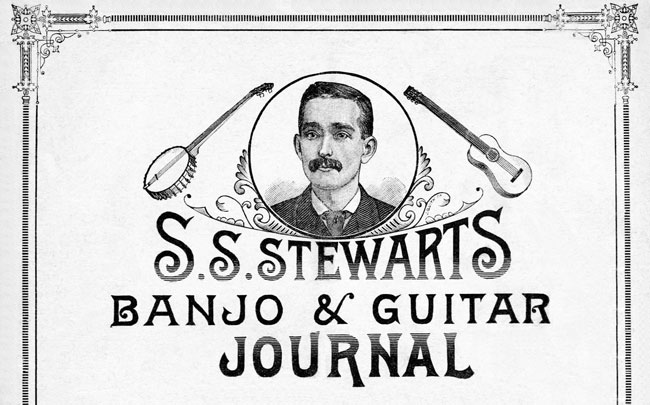
Stewart's magazine was renamed S.S.Stewart's Banjo, Guitar And Mandolin Journal in 1899 during a time known as the BMG Movement, named for the notable contemporary rise in popularity of the banjo, mandolin, and guitar. Other magazines followed Stewart's example, including Cadenza, founded by the music publisher Clarence L. Partee, based originally from 1894 in Kansas City, then from 1900 in New York City, and from 1907 in Boston and with a new owner, Walter Jacobs.
In Britain, the banjo player, composer, instrument maker, and music publisher Clifford Essex launched BMG magazine in 1903. It had a brief interlude calling itself The Guitarist in 1973, even featuring such amplified players as John McLaughlin and Eric Clapton on the cover, but it was soon back to BMG and its regular coverage of mostly acoustic matters. It continues today, and as such qualifies as probably the world's longest-running guitar-related magazine.
Historically important, for sure, but these were magazines of their time (how could it be any other way?), and they reflected the guitar's still relatively lowly position among the other fashionable fretted instruments of the moment. It would take the pop music revolution of the '60s to properly start what we would recognize today as the modern guitar magazine.
With the explosion of guitar-based pop music in the late '50s and early '60s, it was inevitable that a new type of magazine would appear. Before charting some of those moves, though, we need to deal quickly with a technical matter. Publishing people refer to two broad types of specialist magazine: horizontal and vertical. These have nothing to do with the ideal position of the reader, but rather the subject matter. A horizontal magazine covers all varieties of a given topic, while a vertical magazine concentrates entirely on one specific variety.
The first magazine aimed at wannabe pop musicians who fancied their chances on the '60s music scene was just such a horizontal object, and at first it was called Beat Monthly, though it became better known by its slightly later name, Beat Instrumental. It was first published in 1963 by Sean O'Mahony in London (and later that year O'Mahony, a man evidently with a finger on the popular pulse, would launch The Beatles Book Monthly).
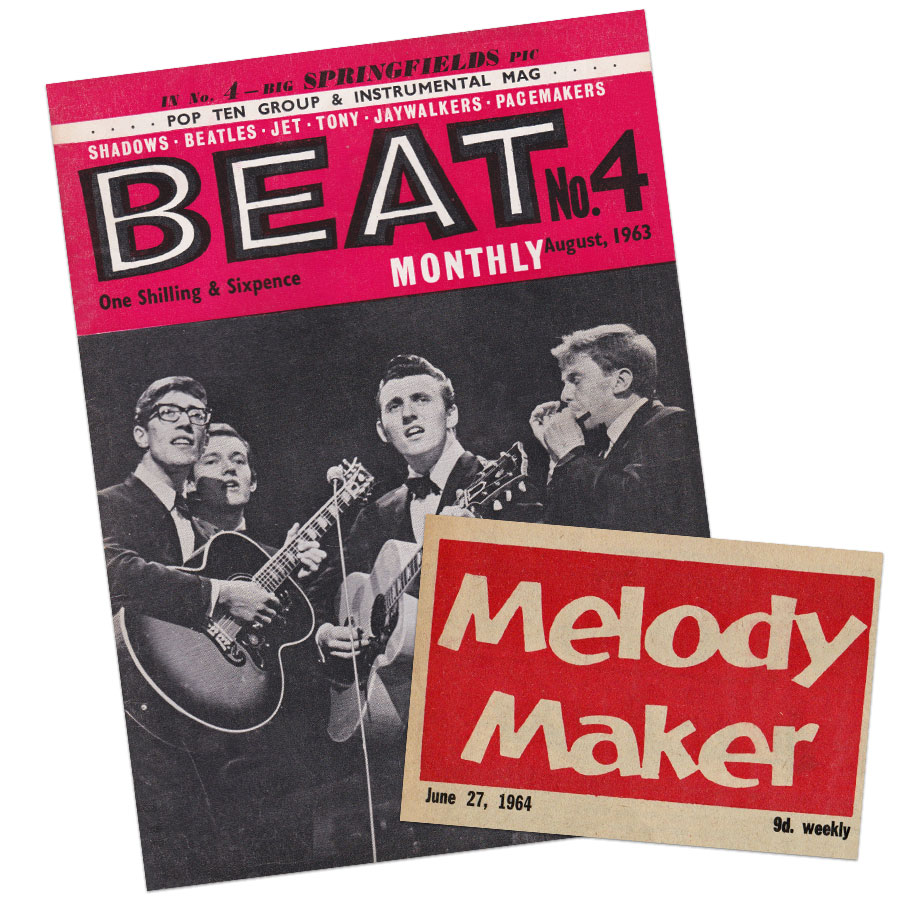
The first issues hovered between a fan's magazine and a musician's magazine, but Beat soon settled down to concentrate to cover not only guitars but also the other gear that pop musicians were interested in—keyboards, drums, amps, PA, and so on—all poured into the medium's traditional categories of interviews, features, news, letters, ads, and so on. It established the idea of a pop music magazine about playing rather than hairstyles.
Britain also had a thriving national weekly pop press, and the granddaddy of them all, Melody Maker, first appeared way back in 1926. It quickly established a significant readership among musicians as well as fans, and by the time Beat appeared, MM had a lively and well used small-ads section for musicians wanted and instruments for sale.
Editorial content aimed at players and their gear was limited in MM to a regular Expert Advice column. For years this had centered on the paper's core readership of dance-band musicians, but by 1964 the new pop stuff was creeping in.
A column that year had a few of the usual troubled enquiries from budding clarinetists and trombonists, but also a request for identification of the type of guitar spotted in a photo of Roy Orbison (apparently a Gretsch Country Club) and the method employed by The Rolling Stones to get a Bo Diddley sound ("a lot of tremolo, plus a bottleneck by Brian Jones").
Later, MM would devote whole editorial pages to reviews and features aimed at musicians, and another British weekly paper, Sounds, launched in 1970, also did a good job with this kind of coverage.
In the mid-'60s, Bud and Maxine Eastman opened a music store, Eastman Studios–Guitar Showcase, in San Jose, California, and then a few years later decided to set up a magazine for guitarists. They launched Guitar Player in 1967, and in the first issue, editor Maxine (under the name Maxine Stock) wrote: "A strong international voice of, by, and for guitar players everywhere has been needed for some time. Here, then, is the inside story, the information you want and need as an amateur or professional. It doesn't matter if you play Indonesian folk songs or Arkansas chicken rock, this publication is for you." She added: "We can't please everyone, but we'll try."

At last, here was the first "vertical" guitar magazine for the modern player—and, as Stock said, one of the notable things about GP right from the start was the range of music it covered. That first issue included Charlie Byrd and Jefferson Airplane, and later ones from '67 had The Byrds, a photo essay on the Magic Mountain festival, an introduction to Mance Lipscomb, and a piece headed "Why Can't You Read Music?" among many others.
All this set the tone for the way GP invited new readers in by covering the latest stuff and then pointed them to music and players and gear and subjects they might not have heard about—which sums up what any good magazine should be about. Jim Crockett was the editor who steered the magazine into the '70s, creating a home for many fine journalists, not least the excellent Tom Wheeler, who edited GP from 1981 to 1991, and Michael Molenda, who was editor from 1997 until 2018.
More guitar-centric magazines followed in Guitar Player's footsteps. They included Guitar, started in England in 1972, Guitar World, begun in New York City in 1980, Guitar For The Practicing Musician, founded in the same city in 1982, and Guitarist, started in England in 1984. The Guitar Magazine appeared in England in 1991, and two new British titles were introduced in 1994, Guitar Techniques and Total Guitar. An early example of online-only was Guitar Interactive, launched in 2011 with no print edition, effectively a digital representation of a page-turning magazine.
One of the most familiar components of today's guitar magazines is the gear review. Reviews should offer useful criticism of a new instrument, amp, or accessory, and magazines have been publishing them for years, with the best and most seasoned reviewers bringing a wealth of experience that can be invaluable to the reader in search of objective information.
However, reviews were rare until the early '70s, and American magazines took longer to include them, with the British magazine Beat Instrumental something of a pioneer. This is all tied up with commerce: Reviews are the place where the line between editorial and advertising can become blurred. Why is this brand chosen for review rather than that one? How unbiased are the reviewer's comments? Astute readers will come to trust reviewers who tell the truth.
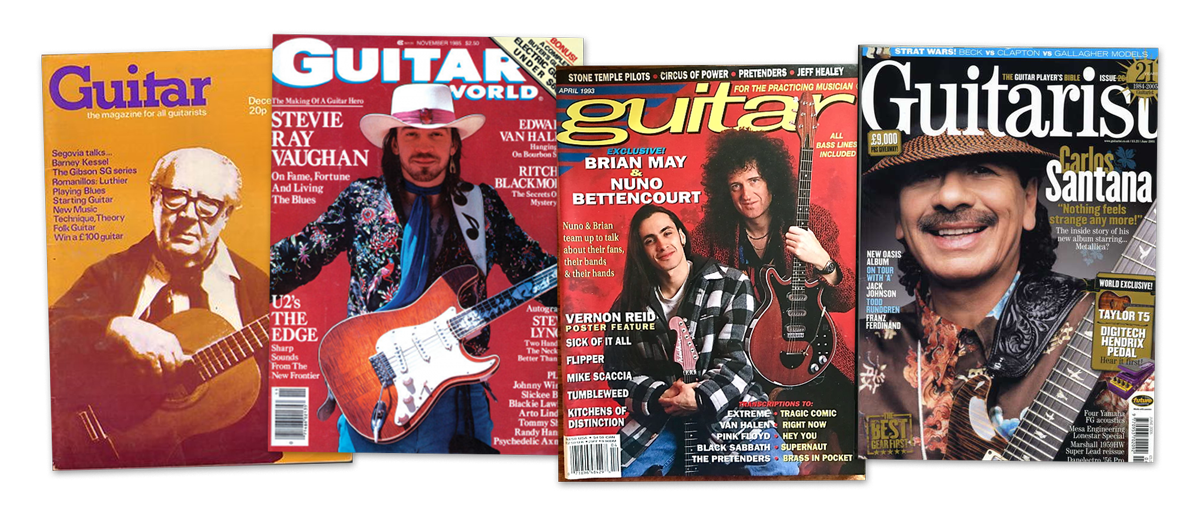
Alongside the broadly guitar-based magazines, others appeared aiming more precisely at specialist strands.
Pickin' was started in 1974, at first concentrating on fretted instruments in bluegrass and old-time country music, and later merging with Frets (not to be confused with the Fender-related Fretts magazine). Acoustic Guitar was started in 1990 and provided a stylish and impressive home for matters unplugged, and in the UK, Acoustic was introduced in 2004, while the American Fretboard Journal first appeared in 2005.
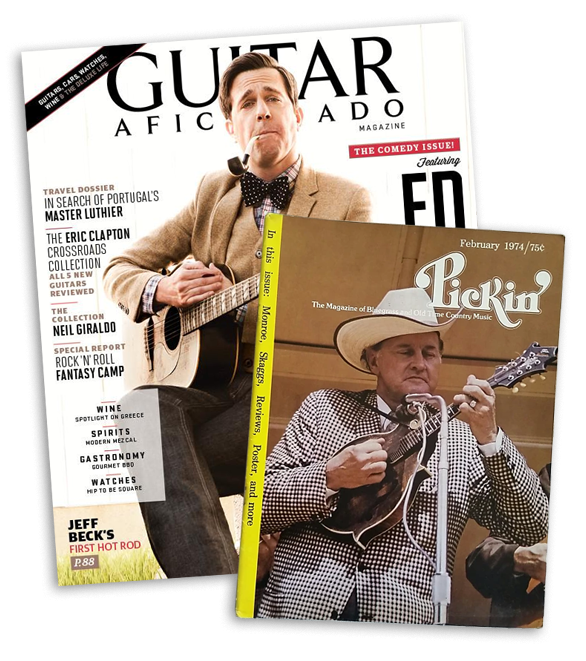
Steel guitarists were served by two US magazines, Steel Guitarist, launched in the mid-'90s, and later Steel Guitar World. There have been several bass and classical-guitar magazines, too, but these are beyond the scope of our survey here.
Vintage fans who wanted a dedicated magazine might have seen Mugwumps, begun in 1971 as a place for classic acoustic guitars, banjos, and mandolins. The more focussed Vintage Guitar Magazine was launched in 1989, growing from The Music Trader to comprehensively cover all matters retro and collectable. A year later, 20th Century Guitar appeared, which managed to survive several years into the 21st century without, appropriately, the need to change its name. Guitar Aficionado was the most recent arrival among these US-based vintage magazines, aiming itself squarely at the high-end collector of the 2010s.
Many of these titles have changed owners since they were launched, some several times. Some magazines have since moved steadily to digital forms, online and through apps, and some have entirely abandoned their print editions. Others have disappeared altogether in what can be a cutthroat business. We don't have the space here to mention every single guitar magazine ever published, of course, but we've tried to cover the main ones.
I grew up editing and writing for print magazines, so I am certainly biased. But I still prefer magazines when they're physical objects. Printing is hundreds of years old, and the process has had plenty of time to reach today's highly advanced state.
Digital systems are much younger and still developing, and in my view they do not yet quite match print for versatility, practicality, or quality in magazines. Digital magazine technology can only improve, though, and the format is clearly an important part of today's guitar-related publishing and, presumably, its future. And, of course, the ability to watch and hear gear demos and guitar lessons—as opposed to merely reading them—certainly has its benefits.
Premier Guitar is an American publication covering a wide spectrum of guitar matters, and it was among the first to demonstrate the value of online. Jon Levy, PG's publisher, says that ever since the debut issue's appearance in February 2007, the magazine has been committed to multimedia.
"I guess you could say that online is in our DNA," he says. He knows guitarists are hungry for high-quality information and content, and that they look for it today in magazines, on websites, via mobile, and on social media. "Premier Guitar simply wants to provide these guitarists with the content that they crave, anywhere they choose to access it. For this reason," Jon says, "our magazine has always been available for free online, in its entirety."
Christopher Scapelliti is Guitar Player's editor-in-chief, and he's well aware of the magazine's position as the longest-running of the modern guitar publications. He says GP has always had what he calls a "laser focus" on tone, technique, and gear, on telling stories that provide insights into guitarists' backgrounds and experiences.
"We remain true to that today," he says, "whether we're speaking with a player about a new or old album, a tour, or how they approach their instrument. Our history is an abiding guide to our present."
Jamie Dickson is editor-in-chief at Guitarist, the longest-running of the modern British guitar magazines. "We have a long-standing and hugely important relationship with our regular readers, some of whom have been buying the magazine since it started over 30 years ago," he says. "That shared history means we understand what those longterm readers want from Guitarist every month—from the kind of gear that they're into, to the artists they're most inspired by, and so on—which hopefully keeps them coming back for more year after year. The challenge, of course, lies in attracting newcomers to our well-established brand without breaking that successful formula."
One thing that can be said of much of the history of guitar magazines—with the notable exception of Maxine Eastman-Jackson and her brief tenure as editor of Guitar Player—is its boys-club legacy. A relative newcomer on the scene, She Shreds, has made it a mission to break that mentality. Founder and Editor-In-Chief Fabi Reyna, speaking with Reverb in 2015, explained her impetus for launching the magazine:
"One of the biggest setbacks that I faced as a young girl learning guitar was that, in mainstream outlets, which for me meant guitar magazines at a big chain grocery store, was struggling to find role models of substance—meaning not overly sexualized—that I could or wanted to relate to. But, perhaps more than anything, not having the option to choose the way that I wanted to learn and being told: 'If you can’t do it the way it’s supposed to be done, then you’re not a real guitar player.'"
In addition to having strong online presence, She Shreds has released 18 (and counting) print issues—all featuring women guitarists and bassists on their covers, including established acts like Sleater-Kinney's Corin Tucker and new talents like Melanie Faye.
The future of the guitar magazine is, like most things, hard to predict. Jon at Premier Guitar says a lot depends on the evolving role of guitar—and music in general—in popular culture, a complex topic in its own right. He applauds the continuing trend where women and girls are breaking down guitar culture's boys-club legacy, and says the globalization of music will help propel guitar into a bright new future.
"For the past five or six years," he adds, "we've seen that guitarists want more videos and more mobile-friendly content. We've entered a period of amazing democratization of guitar content, where just about anyone with a mobile device can create content and build their own audience."
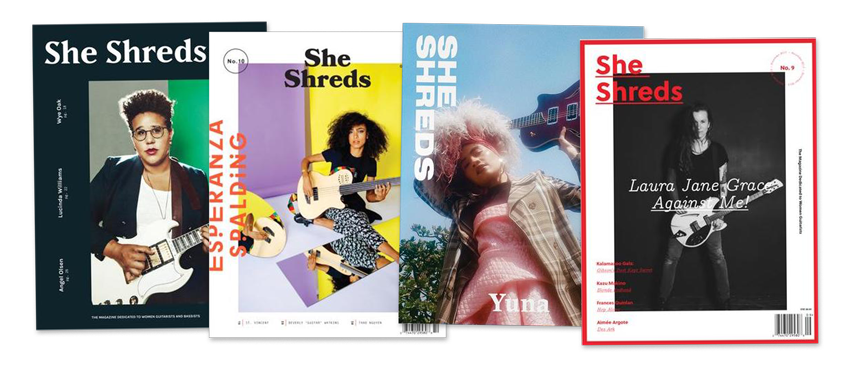
Christopher at Guitar Player admits that the internet has affected all newsstand sales. "We've seen our subscription numbers go up," he says, "either due to the convenience and price of subscriptions, or to readers making a commitment to what we offer. That trend allows us to focus more on giving our core readers what they want and worry less about appealing to the fringes. So, from that perspective, the future appears to be more boutique, more bespoke. It's about serving a more devoted audience with content that speaks directly to their interests."
Jamie at Guitarist says the future lies in understanding what print magazines do best and then accentuating those things in the print version of the magazine—alongside online content from Guitarist and its publisher’s other music magazines collated at the MusicRadar site. The internet has many virtues, he says, but adds that no screen can make a photograph of a '59 Les Paul look achingly beautiful in the way that a carefully crafted magazine can.
"In an age where lots of people suffer from screen fatigue at the end of the day, that's becoming increasingly relevant and attractive. Print magazines suit detailed, long-form journalism. We're not dumbing anything down for clickbait articles, but letting the full story unfold in authoritative, in-depth features adorned by world-leading photography," he says.
Quality print magazines have a secret weapon, Jamie says. "Guitarist is staffed by professionals who have honed their knowledge and skills in a rigorous, quality-focused professional environment for years. You can trust what they have to say and immerse yourself in the vivid richness of the presentation." He says those skills do not have to be limited to print production. "They can also be transferred into beautiful video, engaging online features, and arresting social media that makes newcomers passionate about your brand, even before they're aware you also publish a world-class print product."
"We've entered a period of amazing democratization of guitar content, where just about anyone with a mobile device can create content." - Jon Levy
Jon at Premier Guitar suggests several ways that guitar media companies ought to react to current trends. They should make their content more approachable and immediately accessible, they should partner with bloggers and other creators, and they should focus on areas where they can offer unique material.
"Successful guitar magazines will have to be responsive and boldly creative," he concludes. "And, by the way, they need to respect their audiences and have fun while they're doing it. If you respect the reader and enjoy a kickass good time together, I think that appeal will withstand the test of time. Technology and tastes may change, but guitarists are attracted by a desire for creativity and community—that's what led us to playing the instrument in the first place."
As I thumbed through old copies of print magazines to research this piece, I couldn't help wondering if it will be possible for the guitar historians of the future to find all the content of this or that outdated digital medium. Anyway, putting that tricky question aside, one fascinating game to play as you thumb or swipe through old and not-so-old guitar magazines is to chart the way fashions come and go, how they return and fade and cycle around again.
In this old issue, everyone wants to try tapping. In that one, humbucker'd Teles are in vogue. And then, 24 seems a paltry number of frets. Why not throw away your picks, or buy a bottleneck? Let's get into Mixolydian mode! The cool thing is to remove that vibrato system. The slacker the alternate acoustic tuning, the better. And so on—and suddenly, of course, none of the above. And then, naturally, all of the above, again.
About the author: Tony Bacon writes about musical instruments, musicians, and music. He is a co-founder of Backbeat UK and Jawbone Press, and he was on the editorial staff at International Musician, Sound International, One Two Testing, and Making Music magazines. His latest book is Guitars: The Illustrated Encyclopedia. Tony lives in Bristol, England. More info at tonybacon.co.uk.
